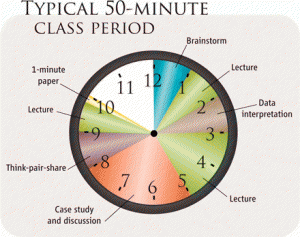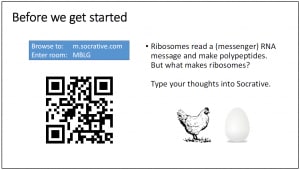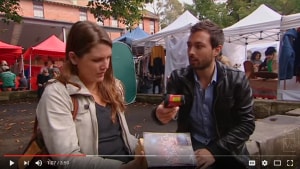In week 4, lecturers across the University opened the doors to their classrooms and invited colleagues in to observe how they engage their students. After the event, we asked observers what approaches they could implement in their own classes. In the first of a short series of posts, we take a look at one of these approaches: ‘chunking’ class time to help students remain attentive and learn more effectively from a lecture format.
Chunking?

A 2008 paper in Science from the University of Wisconsin-Madison analysed the approaches used by effective teachers who implemented evidence-based practices. A key finding was that over two-thirds of class time was used for ‘active learning’, and that each 50-minute lecture-style class was split (chunked) into discrete learning events. Far from banning lectures entirely, the article presents a renewed way to look at the the lecture time period and use it more effectively. Our collective observations during Week 4 // Open Door suggest the same – interspersing instructor-centred delivery with student-focused activities was an effective way to keep students engaged, cover content, and ensure understanding.
Dr Kellie Charles, Senior Lecturer in the School of Medical Sciences, noted after observing a ‘lectorial’ from the School of Information Technologies:
The structure of this interactive lecture (lecture 10′ followed by activity 15′ repeat until end of class time) was great. The students were engaged and working collaboratively at the tasks.
Practical approaches to chunk your class time
In a similar vein to some recent posts on Teaching@Sydney about small changes you can make in your teaching for big impact, those who observed colleagues’ lectures noted a few practical gems of good practice. Here is a collection of what they noticed, and simple suggestions about how you could implement these approaches in your classroom.
I absolutely liked the idea of starting the lecture with quizzes to review the previously taught content.

Dr Fereshteh Pourkazemi, a lecturer from the Faculty of Health Sciences, picked up a great way to get students into the right mindset through starting lectures by reminding students of previous content. Quizzing students on previously taught content is beneficial on a number of levels. It helps to reactivate students’ memory of prior knowledge and prepare for integrating new understanding. The repeated retrieval practice also aids memory and retention of recent concepts. Depending on how the quiz is conducted, student responses could highlight any misconceptions that are being brought forward, which could be addressed quickly at the beginning of the lecture before moving on with new content. Try some of these sample approaches:
- Using Socrative or another student response system, prepare a three question multiple choice quiz that covers the main concepts from the last lecture. Ensure you discuss the responses so that the students aren’t wondering.
- Instead of a multiple choice quiz, ask students a short answer question that applies some knowledge from the last lecture and also has some connection to the current lecture.
- Arrive at the lecture venue early and open the quiz to students as they are settling in, before 5 past the hour. Then, spend the first two minutes reviewing their responses.
Use a variety of media and activities to maintain interest and engagement of a large cohort.
Pamela Brañas, an educational designer in the Educational Innovation team, noticed the power of variation and multimedia to keep students engaged. Videos are a primary mode of content consumed in massive quantities by today’s students, and there are many publicly-available videos that can be related to your content. These can be used to not only provide an attention break but also serve a higher purpose, such as linking class content to examples and applications from the real world. In the chunked lecture, activities can also punctuate delivery. These activities can include questions that students respond to through student response systems, and/or hard-copy worksheets where students need to apply their understanding to physically write or draw a response. Dr Slade Matthews, a senior lecturer in pharmacology, noted that “worksheets were good to get students actually doing things in lectures”; worksheets deserve a full post on their own, so we’ll follow this up in a subsequent article on Teaching@Sydney. For the time being, try some of these simple approaches:

- Find a short YouTube video that relates in some way to the concepts being covered. This could be an explanation, a news piece, an animation of an abstract process, an example or application of a theory, etc.
- Combine the video with an activity halfway. For example, show a portion of the video, and then ask students to predict what comes next. What happens when the rocket is ignited? How will the crowd in the video respond to the stimulus, and why? As Dr Andre Kyme (ARC DECRA fellow in the School of Physics) noted, it was effective to use “short videos to raise concepts, stimulate discussion and encourage problem solving.”
- To get students donning their critical hats, find a video which explains a concept poorly or with glaring (or not so glaring) mistakes. Ask students to pick problems and suggest solutions. Combine with a student response system to gauge opinions from more students.
Employing small group discussion and then asking for feedback from those groups (to overcome the silence that pervades any usual question time in lectures!)
Dr Helen Parker, a lecturer from the University of Sydney Business School, picked up a neat approach to avoid the awkward tumbleweed phenomenon that seems to surface when questions are posed to students. Asking students to discuss a question first in smaller groups (or even just the person sitting next to them) will ease them into sharing their thoughts in a safer (less public) environment. You can then ask for feedback from groups through a variety of methods; for example, Dr Murray Thomson, a senior lecturer in the School of Life and Environmental Sciences, observed that a useful technique was to “encourage students to solve a problem and use a student answer to present the material to the class.” Activities and discussions are great to punctuate a lecture, but it’s important to keep the pace and rhythm going; Dr Helena Robinson, a lecturer in museum studies, noted that a “quick turnaround (2-5 min) group work to punctuate lectures” worked well. Try some of these simple approaches:

- Ask questions that are purposely designed to target misconceptions, elicit controversial responses, or require deeper analysis and thinking. Try to avoid questions which are too straightforward, as this risks diluting the value of group discussion and infantilising the content.
- Share students’ thoughts by showing a student’s worksheet on the document camera, or asking them to share their group’s solution through the microphone, or having students submit responses through Socrative (and project these on screen). When doing this, be sure to (1) be encouraging and affirm the students’ contribution, even if the answer(s) are not what you expect, and (2) present/discuss an optimal solution yourself to ensure students are on the same page.
An anonymous observer in the Week 4 // Open Door event said that it was effective to be “asking more questions of students. Not worrying about covering all the content – engagement with students’ questions is of more value to their learning of the topic”. This is a key observation – in order to chunk our lectures, we need to be ready to accept that deeper coverage of key concepts is more important that surface coverage of many concepts. This will most likely mean that we need to move (or remove) some content so that we can help students engage with what is most important.
Tell me more!
- Miller, S. et al. (2008) Scientific Teaching in Practice. Science, 322:1329-1330.
- Video of an #edTech talk on free tools to foster student engagement and participation.
- If you have any thoughts or questions about anything mentioned here, please post to the Educational Innovation Yammer group – we’d love to keep the conversation going.
- In the next post in this series, we’ll take a look at how colleagues successfully incorporate research and authenticity in lectures. Stay tuned!






1 Comment